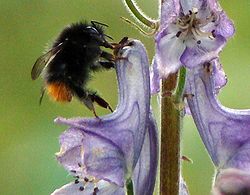| Alpigenobombus | |
|---|---|
 | |
| Scientific classification | |
| Kingdom: | Animalia |
| Phylum: | Arthropoda |
| Class: | Insecta |
| Order: | Hymenoptera |
| Family: | Apidae |
| Genus: | Bombus |
| Subgenus: | Alpigenobombus |
Alpigenobombus is a subgenus of nectar-robbing bumblebees found in Palearctic. This subgenus is easily identified by the unique, six-toothed mandibles of the females, a specialized adaptation for robbing nectar from tubular flowers. [1]
The taxonomy of this subgenus is complex, and the classification of its species has been subject of an ongoing debate. [1]